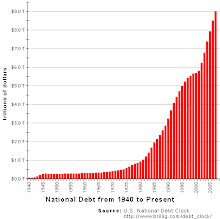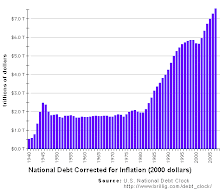
U.S. Public Debt as a Percentage of Gross Domestic Product (GDP)
Whenever a person applies for a loan, the bank (or other lending institution) requires the borrower to provide vast amounts of information on employment history, income, expenses, and other debts. The loan officer is trying to determine the likelihood that the borrower will pay back the loan. Loan officers acknowledge that the acceptable level of debt for an individual depends on that person´s wealth and income. A $10,000 credit card bill for Bill Gates (one of the wealthiest people in the world) is of much less concern than the same bill for an unemployed college student of modest means.
The same argument can be made for countries. As a country´s wealth increases, it is able to increase its debt and maintain the same perceived ability to pay it back. Thus, many analysts argue that the correct way to look at public debt is in relation to a country´s gross domestic product (GDP). Even by this measure, the U.S. public debt has increased dramatically since 1981.
See also the "U.S. Public Debt Since 1940" and the "U.S. Public Debt Since 1940 - Adjusted for Inflation".






The debts out of hand.
ReplyDelete